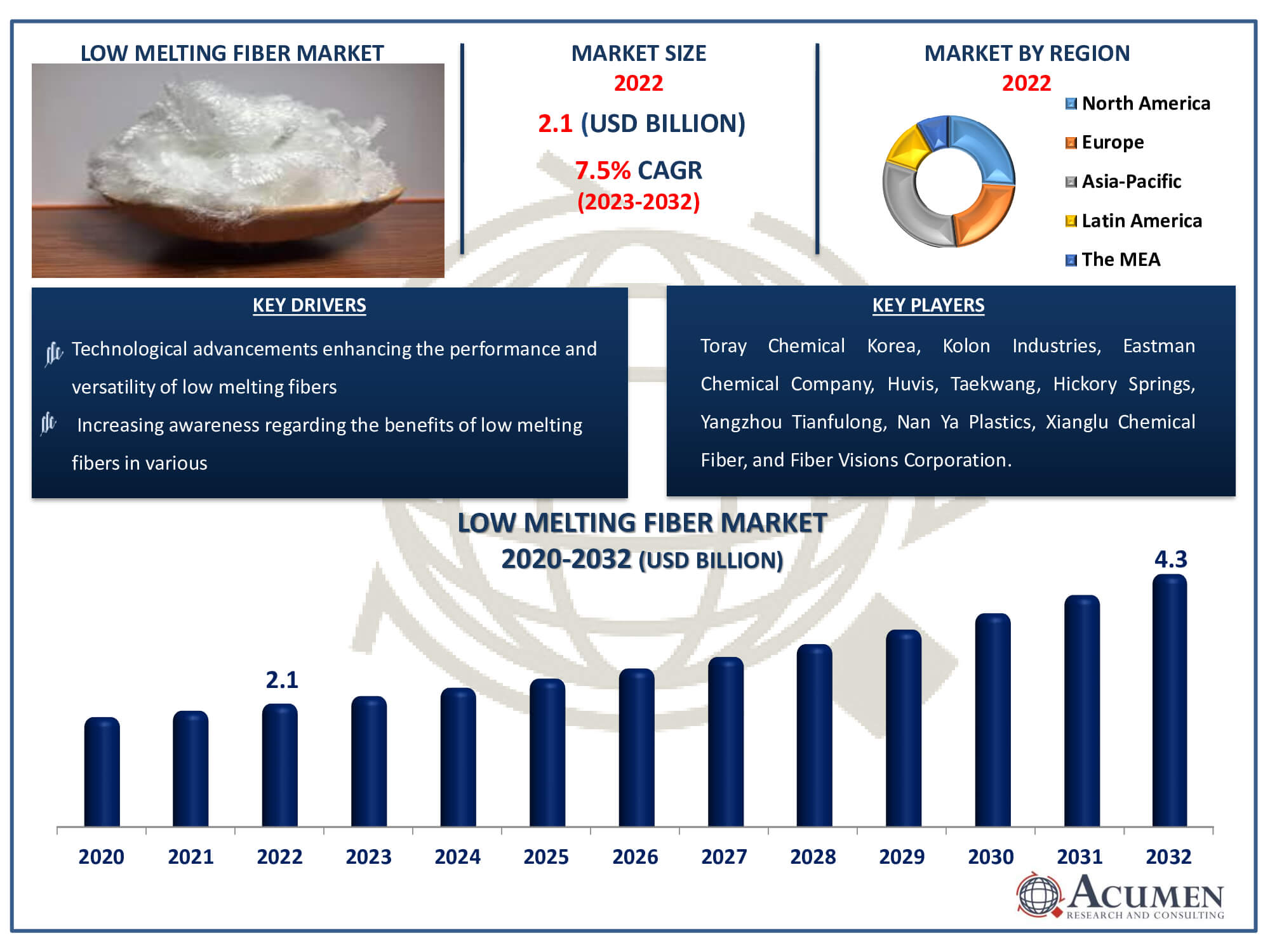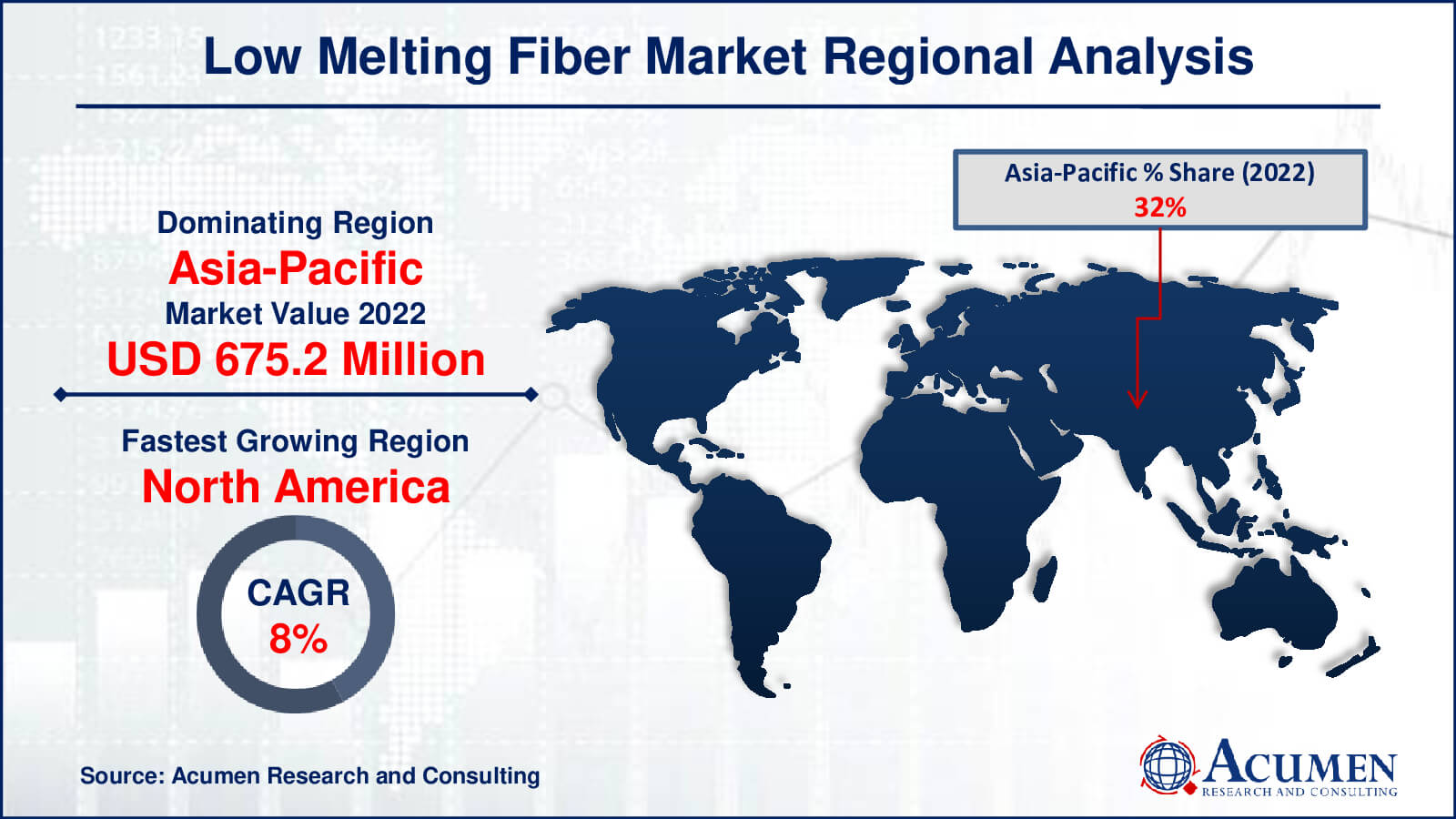April 2025
Low Melting Fiber Market Size accounted for USD 2.1 Billion in 2022 and is estimated to achieve a market size of USD 4.3 Billion by 2032 growing at a CAGR of 7.5% from 2023 to 2032.
The Low Melting Fiber Market Size accounted for USD 2.1 Billion in 2022 and is estimated to achieve a market size of USD 4.3 Billion by 2032 growing at a CAGR of 7.5% from 2023 to 2032.
Low Melting Fiber Market Highlights

Low melting fiber is manufactured using a bi-component blend of modified polyester and general polyester. It melts at lower temperatures, typically between 110ºC and 200ºC, compared to normal fibers, and is bonded with other fibers to enhance adhesive strength. These fibers are utilized in hygiene products, produced through bi-component spinning technology involving polyethylene and polypropylene. Both polyethylene and polypropylene possess softer characteristics than standard polyester low melting fibers. These low melting fibers are employed in multifunctional materials to impart hydrophilic or hydrophobic properties, resulting in a high lofted soft non-woven fabric. Applications of low melting fibers include the hygiene industry, bedding (quilts, mattresses, padding), and vehicle interiors.
Low melting fiber refers to a bi-component fiber utilized as a thermal bonding agent, typically featuring a sheath/core structure composed of a sheath polymer and a core polymer. The melting point of the sheath polymer is lower than that of the core polymer, allowing the fiber to melt at a lower temperature and bond with other solid polyester fibers, thereby reinforcing the resulting mixed fiber. These bonds with alternative polyester fibers are employed in the production of materials such as wadding, insulation, and padding. The utilization of low melting fibers extends across a wide range of downstream applications, including automotive lining, soundproofing, insulation, and batting. The global low melting fiber market is primarily driven by the increasing demand in the bedding and automotive industries.
Global Low Melting Fiber Market Dynamics
Market Drivers
Market Restraints
Market Opportunities
Low Melting Fiber Market Report Coverage
| Market | Low Melting Fiber Market |
| Low Melting Fiber Market Size 2022 | USD 2.1 Billion |
| Low Melting Fiber Market Forecast 2032 | USD 4.3 Billion |
| Low Melting Fiber Market CAGR During 2023 - 2032 | 7.5% |
| Low Melting Fiber Market Analysis Period | 2020 - 2032 |
| Low Melting Fiber Market Base Year |
2022 |
| Low Melting Fiber Market Forecast Data | 2023 - 2032 |
| Segments Covered | By Type, By Application, And By Geography |
| Regional Scope | North America, Europe, Asia Pacific, Latin America, and Middle East & Africa |
| Key Companies Profiled | Toray Chemical Korea, Kolon Industries, Eastman Chemical Company, Huvis, Taekwang, Hickory Springs, Yangzhou Tianfulong, Nan Ya Plastics, Xianglu Chemical Fiber, and Fiber Visions Corporation. |
| Report Coverage |
Market Trends, Drivers, Restraints, Competitive Analysis, Player Profiling, Covid-19 Analysis, Regulation Analysis |
Low Melting Fiber Market Insights
Low melting fiber, possessing superior properties and greater efficiency compared to substitutes such as cotton, wool, and nylon, is increasingly preferred by the manufacturing industry, driving market growth. The rise in demand for recycled staple fibers, fueled by awareness regarding environmental protection, further boosts global market demand. Additionally, the availability of a wide range of stylish designs, bright colors, and attractive prints enhances the appeal of low melting fiber products. However, instability in petroleum prices leads to fluctuations in raw material prices, as petroleum is used in manufacturing the product, which finds applications in various sectors such as fabrics, textiles, rugs, and carpets. The forecasted market growth is primarily attributed to two key areas: clothing and furnishing. The downstream applications of low melting fiber are wide-ranging, with its increasing significance observed in various fields including Automotive, Bedding Industry, Construction, and others. Globally, the low melting fiber market is predominantly driven by the growing demand from the automotive industry, which accounts for nearly 52.98% of total downstream consumption of low melting fiber worldwide.
The growing demand for low melting fiber in various applications such as mattresses, bedding, and padding is anticipated to fuel the market in the near future. However, strict environmental regulations related to the non-biodegradability may restrain the market in the low melting fiber industry forecast period. Despite this, the increasing demand for specialty mattresses due to consumers' preference for environmentally friendly products is expected to provide new growth avenues for the market in the coming years. Low melting fiber is eco-friendly, adheres to low temperatures, and possesses excellent bonding, enhanced mixing properties, and high resilience, which will continuously drive its demand.
Low Melting Fiber Market Segmentation
The worldwide market for low melting fiber is split based on type, application, and geography.
Low Melting Fiber Types
According to low melting fiber industry analysis, the global market is segmented into two categories: melting point ≤130 and melting point >130. The melting point ≤130 segment is estimated to hold the majority of the market shares in 2022. This segment encompasses low melting fibers with a melting point equal to or below 130 degrees Celsius.
Fibers in this sector with low melting points have several benefits. First of all, their eco-friendliness makes them desirable to industries and consumers who care about the environment. Second, these fibers process well in a variety of manufacturing applications because they stick well to low temperatures. They also have outstanding bonding properties, which guarantee robust fiber connections and improve the final product's overall integrity. Additionally, their better mixing qualities allow for equal dispersion inside composite materials, which enhances consistency and performance. Finally, their strong resilience guarantees endurance and durability, which adds to their attraction to producers and consumers.
Because of these qualities, it is anticipated that in the projected year, there will be a further increase in demand for low melting fibers with a melting point of ≤130 degrees Celsius. It is anticipated that manufacturers in several industries, including textiles, automotive, construction, and hygiene goods, would utilize these fibers more frequently in order to reap the advantages of their higher performance qualities, processing efficiency, and environmental friendliness.
Low Melting Fiber Applications
In terms of application, the mattress segment held the largest market share in both volume and value for low melting fiber. The growth in the mattress segment is attributed to increasing demand from households as well as commercial and institutional sectors, including hospitals, education, and the corporate sector. The growth of the hospitality sector is also serving to boost the mattress market, driven by an increased demand for mattresses promising excellent comfort and sound sleep. Non-woven low melt fibers, known for preventing bed bug infestations, are extensively used in mattresses. Additionally, low melt fibers exhibit excellent resilience and bonding properties, further driving demand in the mattress segment of the low melting fiber market.
Furthermore, the growing demand from the automotive industry will boost the demand for the car molding segment in the low melting fiber market forecast period. Car molding accounts for a significant share of the total low melting fiber market. The demand for lightweight cars is on the rise as weight reduction is a cost-effective method for reducing greenhouse gas emissions and fuel consumption. Consequently, there is an increasing demand for lightweight automotive components with higher durability. Low melting fibers are used in the production of heat and vacuum applicators (HVA), which are utilized in automotive interior composites such as wadding, insulation, filtration, and automotive acoustic insulation materials. They are also applied in car trunks, wheel arches, carpets, and other areas.
Low Melting Fiber Market Regional Outlook
North America
Europe
Asia-Pacific
Latin America
The Middle East & Africa

Low Melting Fiber Market Regional Analysis
Geographically, Asia-Pacific is the largest region; China represents the fastest-growing segment for low melting fiber, accounting for the majority of the world’s production. In 2010, China manufactured over 20 million tons of low melting fiber. As the second-largest consumer of petroleum, China benefits from the availability of the byproduct of petroleum distillation, which serves as the feeder material for low melting fiber production. China was the largest importer of low melting fiber in 2016, driven by increasing textile and carpet industries, as well as rising construction activities.
The North American market demonstrates significant growth, propelled by the rapid expansion of the automotive and home furnishing industries, coupled with the growing bedding sector. The rise in population, along with increasing urbanization rates, positively impacts the home furnishings market in the US. Polyester is a commonly used material in automobile fabric manufacturing, and the demand for lighter automotive materials for improved efficiency and performance is expected to fuel the demand for enhanced automotive interiors, consequently increasing the demand for low melting fibers over the forecast period.
The European market shows moderate growth, driven by increasing consumer interest in home furnishings. These fibers are essential for manufacturing mattresses, blankets, upholstery, wall coverings, soft home furnishings, carpets, and similar products. The development in the real estate sector fuels the demand for home furnishings. Additionally, the presence of retail stores providing home furnishings and the rising industrial applications, along with increasing urbanization rates, contribute to the market growth in Europe.
Low Melting Fiber Market Players
Some of the top low melting fiber companies offered in our report includes Toray Chemical Korea, Kolon Industries, Eastman Chemical Company, Huvis, Taekwang, Hickory Springs, Yangzhou Tianfulong, Nan Ya Plastics, Xianglu Chemical Fiber, and Fiber Visions Corporation.
Looking for discounts, bulk pricing, or custom solutions? Contact us today at sales@acumenresearchandconsulting.com
April 2025
May 2024
March 2024
March 2025